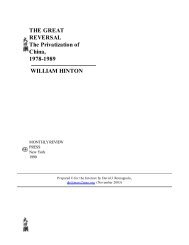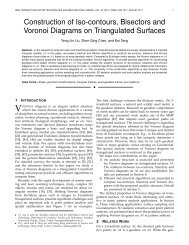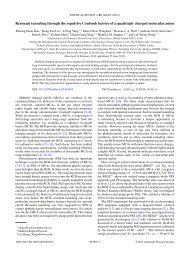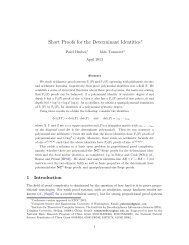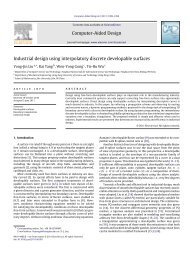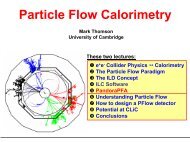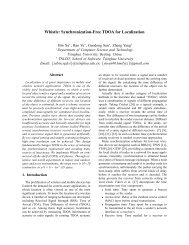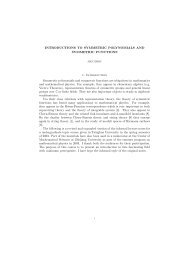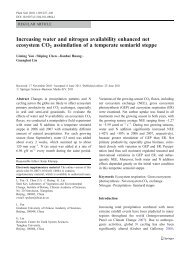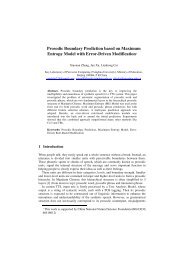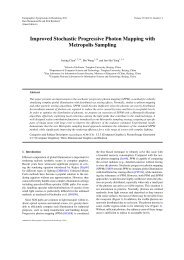Feature Preserving Mesh Simplification Using Feature Sensitive Metric
Feature Preserving Mesh Simplification Using Feature Sensitive Metric
Feature Preserving Mesh Simplification Using Feature Sensitive Metric
Create successful ePaper yourself
Turn your PDF publications into a flip-book with our unique Google optimized e-Paper software.
604 J. Comput. Sci. & Technol., May 2010, Vol.25, No.3<br />
Fig.12. Simplifying Ateneam model with various feature sensitivity arguments, 15 104 to 1 992 tri.: All simplified models is derived by<br />
FS method without blow-up, ω is set as 0, 0.01, 0.03, 0.1, 0.3. If ω is set to 0, the result is similar to the previous QEM method. When<br />
ω is upgraded, more triangles are retained on the sharp edges but distortion is also occurred at the planar regions.<br />
for simplified mesh. Fig.12 shows a series of simplified<br />
Ateneam models with different w in ascending order.<br />
We see the facial features are approximated by<br />
further patches under larger weights. However, large<br />
weight may cause too large distortions on planar regions.<br />
When w is upgraded to 0.3, though the details<br />
of eyes and mouth are preserved well, the overall appearance<br />
of facial form becomes unacceptable.<br />
Although our inception is focused on the accuracy<br />
but is not efficiency during simplification, we are still<br />
concerned about performance. A direct speculation is<br />
that, as FS methods take more dimensions into account,<br />
and iterate at each step, we have to cost more time<br />
than QEM method. We implemented our method and<br />
QSlim is also integrated into the same testing framework,<br />
comparing the performance for both methods on<br />
a laptop with Intel Duo 2.5 GHz processor and 2 GB<br />
main memory. Table 2 shows the comparison results<br />
for each model used in this paper. Our approach costs<br />
around double times than QSlim in most cases. This is<br />
an limitation of FS method that there exists a tradeoff<br />
between appearance, speed and interactivity, but it<br />
is still faster than some other appearance preserving<br />
based method like [15], that is mentioned as three to<br />
twenty times slower than QEM. For fair comparison, we<br />
do not introduce any special scheme for acceleration, so<br />
there are quite a lot strategies which can be employed<br />
for further improvement, e.g., using vertex heap rather<br />
than edge heap [18] . The performance of FS method is<br />
also related to the input quality, for the reason that a<br />
complex model may bring more iteration steps.<br />
Table 2. Time Comparison (in ms)<br />
Models No. Faces QSlim FS<br />
Horse 10 024 180 312<br />
Leopard 65 024 1 224 2 612<br />
RockerArm 80 354 1 650 3 129<br />
HappyBudda 123 056 2 663 4 922<br />
Lucy 237 278 5 399 9 871<br />
LittleThinking 401 985 8 249 17 463<br />
6 Conclusions and Future Work<br />
We have presented a new simplification algorithm<br />
based on FS metric. According to the constraint conditions,<br />
we construct error metric by using the sum of the<br />
squared distance from a 6D point to its corresponding<br />
two-dimensional hyperplane rather than in R 3 . Moreover,<br />
we employed a constrained optimization to acquire<br />
contraction target point which satisfies the geometric<br />
constraint on normal directions, this strategy<br />
may also be combined with other normal-geometry related<br />
cases. Experimental results demonstrated that<br />
this algorithm can preserve feature more precisely under<br />
the global geometry, and then naturally retain more<br />
patches on the feature regions without special feature<br />
recognitions during the simplification process.<br />
Taking the advantage of blow-up phenomenon in FS<br />
space, our method can produce more suitable result and<br />
high visual quality on feature regions.<br />
However, as we have known that the tradeoff between<br />
efficiency and accuracy has become the bottleneck<br />
to simplification, feature sensitive simplification<br />
with the high-performance computing technology may<br />
become a significative research topic.<br />
References<br />
[1] Heckbert P, Garland M. Survey of polygonal surface simplification<br />
algorithms. In SIGGRAPH 1997 Course Notes: Multiresolution<br />
Surface Modeling, 1997.<br />
[2] Garland M, Heckbert P. Surface simplification using quadric<br />
error metrics. In Proc. SIGGRAPH, Los Angeles, USA,<br />
Aug. 3-8, 1997, pp.209-216.<br />
[3] Hoppe H. New quadric metric for simplifying meshes with<br />
appearance attributes. In Proc. the 10th IEEE Visualization<br />
Conference, San Francisco, USA, Oct. 24-29, 1999, pp.59-66.<br />
[4] Yan J, Shi P, Zhang D. <strong>Mesh</strong> simplification with hierarchical<br />
shape analysis and iterative edge contraction. IEEE Transactions<br />
on Visualization and Computer Graphics, 2004, 10(2):<br />
142-151.<br />
[5] Jong B S, Teng J L, Yang W H. An efficient and low-error<br />
mesh simplification method based on torsion detection. The<br />
Visual Computer, 2005, 22(1): 56-67.<br />
[6] Kimmel R, Malladi R, Sochen N. Image as embedded maps<br />
and minimal surfaces: Movies, color, texture and volumetric<br />
medical images. International Journal of Computer Vision,<br />
2000, 39(2): 111-129.



